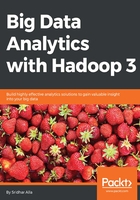
The MapReduce framework
MapReduce is a framework used to compute a large amount of data in a Hadoop cluster. MapReduce uses YARN to schedule the mappers and reducers as tasks, using the containers. The MapReduce framework enables you to write distributed applications to process large amounts of data from a filesystem, such as a Hadoop Distributed File System (HDFS), in a reliable and fault-tolerant manner. When you want to use the MapReduce framework to process data, it works through the creation of a job, which then runs on the framework to perform the tasks needed. A MapReduce job usually works by splitting the input data across worker nodes, running the mapper tasks in a parallel manner.
At this time, any failures that happen, either at the HDFS level or the failure of a mapper task, are handled automatically, to be fault-tolerant. Once the mappers have completed, in the results are copied over the network to other machines running the reducer tasks.
An example of using a MapReduce job to count frequencies of words is shown in the following diagram:

MapReduce uses YARN as a resource manager, which is shown in the following diagram:

The term MapReduce actually refers to two separate and distinct tasks that Hadoop programs perform. The first is the map job, which takes a set of data and converts it into another set of data, where inpidual elements are broken down into tuples (key/value pairs).
The reduce job takes the output from a map as input and combines those data tuples into a smaller set of tuples. As the sequence of the name MapReduce implies, the reduce job is always performed after the map job.
The input to a MapReduce job is a set of files in the data store that is spread out over the HDFS. In Hadoop, these files are split with an input format, which defines how to separate a file into input splits. An input split is a byte-oriented view of a chunk of the file, to be loaded by a map task. Each map task in Hadoop is broken into the following phases: record reader, mapper, combiner, and partitioner. The output of the map tasks, called the intermediate keys and values, is sent to the reducers. The reduce tasks are broken into the following phases: shuffle, sort, reducer, and output format. The nodes in which the map tasks run are optimally on the nodes in which the data rests. This way, the data typically does not have to move over the network, and can be computed on the local machine.
Throughout this chapter, we will look at different use cases, and how to use a MapReduce job to produce the output desired; for this purpose, we will use a simple dataset.